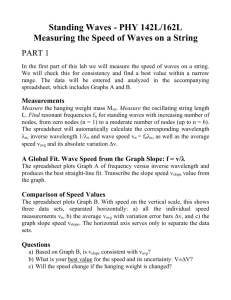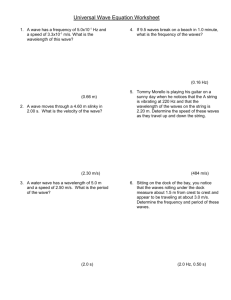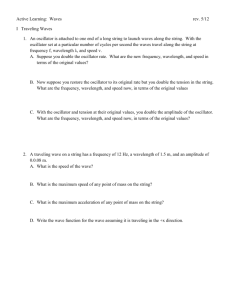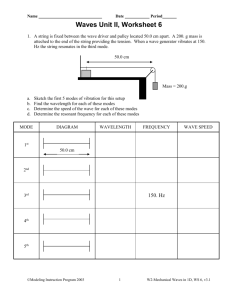Standing Waves on a Vibrating String
advertisement
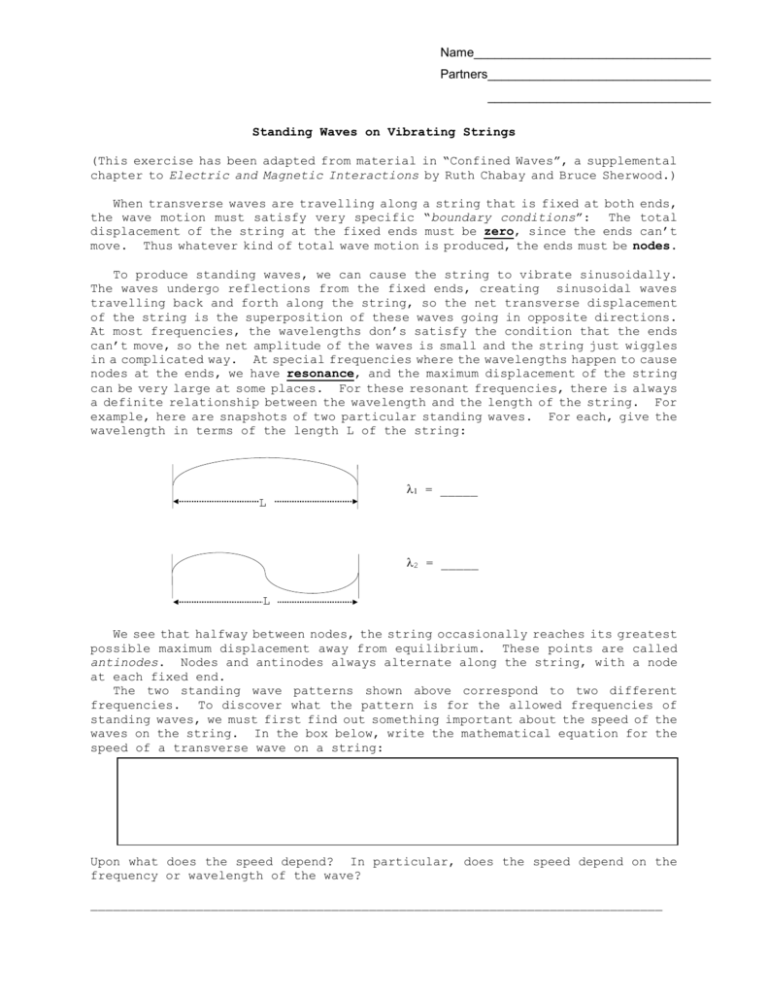
Name__________________________________ Partners________________________________ ________________________________ Standing Waves on Vibrating Strings (This exercise has been adapted from material in “Confined Waves”, a supplemental chapter to Electric and Magnetic Interactions by Ruth Chabay and Bruce Sherwood.) When transverse waves are travelling along a string that is fixed at both ends, the wave motion must satisfy very specific “boundary conditions”: The total displacement of the string at the fixed ends must be zero, since the ends can’t move. Thus whatever kind of total wave motion is produced, the ends must be nodes. To produce standing waves, we can cause the string to vibrate sinusoidally. The waves undergo reflections from the fixed ends, creating sinusoidal waves travelling back and forth along the string, so the net transverse displacement of the string is the superposition of these waves going in opposite directions. At most frequencies, the wavelengths don’s satisfy the condition that the ends can’t move, so the net amplitude of the waves is small and the string just wiggles in a complicated way. At special frequencies where the wavelengths happen to cause nodes at the ends, we have resonance, and the maximum displacement of the string can be very large at some places. For these resonant frequencies, there is always a definite relationship between the wavelength and the length of the string. For example, here are snapshots of two particular standing waves. For each, give the wavelength in terms of the length L of the string: = _____ L 2 = _____ L We see that halfway between nodes, the string occasionally reaches its greatest possible maximum displacement away from equilibrium. These points are called antinodes. Nodes and antinodes always alternate along the string, with a node at each fixed end. The two standing wave patterns shown above correspond to two different frequencies. To discover what the pattern is for the allowed frequencies of standing waves, we must first find out something important about the speed of the waves on the string. In the box below, write the mathematical equation for the speed of a transverse wave on a string: Upon what does the speed depend? In particular, does the speed depend on the frequency or wavelength of the wave? ____________________________________________________________________________ ____________________________________________________________________________ ____________________________________________________________________________ Write the mathematical relationship between the speed, wavelength, and frequency of a wave: Since the speed of the wave doesn’t depend on the wavelength (or the length of the string), all waves travel along the string at the same rate, and the frequencies of the waves can be calculated from the tension, linear density, and wavelength. In the box below, derive the mathematical expressions for the frequencies of the two waves on Page 1: The longest wavelength standing wave is the one with wavelength 1 ( = 2L). The frequency f1 of that wave is called the fundamental for the string. The next highest allowed frequency is that for the wave with wavelength 2 ( = L). How is f2 related to f1? Now you’ll derive a few more wavelengths and frequencies. Strings Classwork 2 Using the boundary conditions (Node at each end of the string) and the fact that there is always an antinode between each pair of nodes, find the wavelengths and frequencies for the cases given below. Give in terms of L and f in terms of f1. 3 = _____ L f3 = _____ 4 = _____ L f4 = _____ 5 = _____ L f5 = _____ Do you feel you have found a general rule for predicting the allowed wavelengths and frequencies of standing waves on a string that is fixed at both ends? Please state the rule mathematically here: Question If you wanted to raise the frequency of the fundamental for a string, how could you do that? You can’t change the string itself, so its density is constant. Strings Classwork 3



